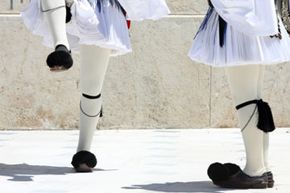People of Greek heritage may have a reputation for throwing plates around, but it's not because they don't want to do the dishes. Rather, smashing plates is time-honored tradition you might observe at a Greek restaurant or wedding reception. Origins of the practice are murky, but it may have begun in ancient Greece, and is said to have brought about the idea of kefi, which translates to good spirits and fun. Some also believe that breaking plates can ward off evil spirits or, at a wedding reception, bring good luck. Others just smash plates to show their appreciation for the band that's accompanying their revelry.
But of course, flying shards of pottery can be dangerous, so plate smashing was outlawed in the taverns of Greece in 1969. The practice still persists, however -- though sometimes it may take different, safer forms, such as flower throwing [sources: Lusher, Time].
Advertisement
Regardless of where it came from or how it's done, the endurance of the plate smashing tradition undeniably tells us something about the uniqueness of the Greek culture and its love of kefi. But Greek traditions go far beyond parties and dinnerware. Located at the crossroads of the world, between Europe and Asia, Greece has influenced civilization for thousands of years, helping to shape the fields of philosophy, mathematics, astronomy, sports, politics, literature and architecture.
Because of this rich history, the nation's culture is full of traditions, many of which stem from the importance of religion in Greek society. Once Emperor Constantine legally recognized Christianity in 312 A.D., the Greek Orthodox Church became a major influence in everyday Greek life. Specific religious festivals and rituals -- which you'll learn more about later in this article -- surrounding everything from birth and birthdays to marriage to death keep people's lives firmly rooted in the church and in Greek culture.
Family is also at the core of many Greek cultural traditions. For those of Greek heritage, immediate kin are often the most important people in their lives. Gender also plays an important role in the family dynamic; traditionally, males are more often in the public eye, and women tend to be comparatively private, preferring to serve as stalwarts of the church. In recent decades, however, this distinction has faded, with women entering the workforce and even taking up public office.
One thing that hasn't changed, though, is the Greeks' love of socializing around a spread of traditional food. Read on to savor more.





